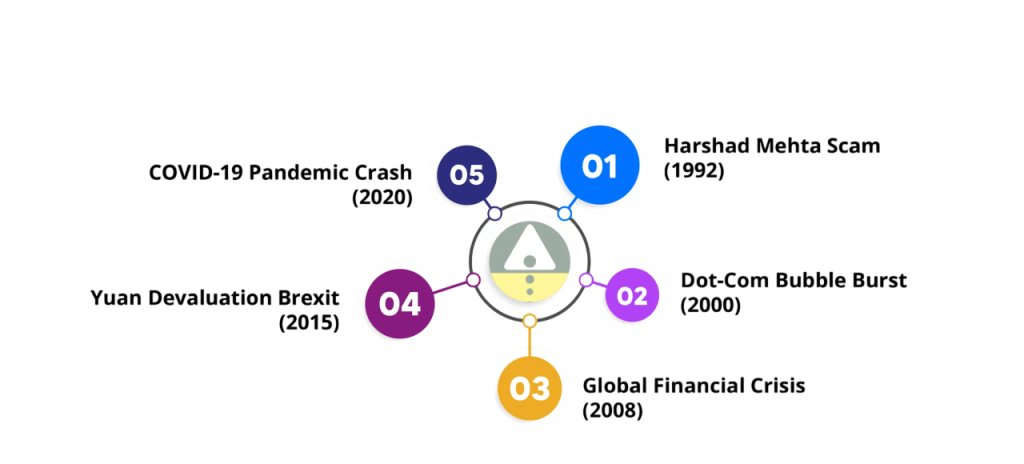
- Definition and History
- Major Global Crashes
- Causes of Market Crashes
- Role of Speculation and Bubbles
- Investor Behavior During Crashes
- Government Intervention
- Recovery Patterns
- Impact on Global Economy
- Conclusion
Definition and History
A stock market crash is typically defined as a rapid, double-digit percentage drop in market indexes within a short time frame. Unlike typical market corrections, crashes occur suddenly, often in response to unexpected economic or financial shocks.Stock market crashes represent sudden and sharp declines in stock prices across a significant portion of the Causes of Market Crashes. Often fueled by panic selling and triggered by economic, geopolitical, or systemic financial issues, these events have the potential to impact the global economy, erase wealth, and shake investor confidence. This comprehensive guide explores the concept of stock market crashes in depth, from historical examples to strategies for mitigation and prevention.
Do You Want to Learn More About Database? Get Info From Our Database Online Training Today!
Major Global Crashes
Several significant crashes have affected markets worldwide:

- The Great Depression (1929–1939): Triggered by speculative investments and margin buying.
- Black Monday (1987): Caused by algorithmic trading and investor panic.
- Dot-com Bubble (2000): Driven by overvaluation of internet companies.
- Global Financial Crisis (2008): Sparked by subprime mortgage failures.
- COVID-19 Pandemic (2020): A health crisis leading to economic lockdowns.
Each crash had different root causes but shared patterns in investor behavior and economic consequences.
Causes of Market Crashes
Stock market crashes often stem from a mix of macroeconomic, geopolitical, and behavioral factors:
- Overvaluation: When stock prices exceed intrinsic value.
- Excessive Leverage: Margin trading and borrowing amplify risks.
- Economic Shocks: Recessions, inflation spikes, or interest rate hikes.
- Geopolitical Events: Wars, terrorism, and political instability.
- Speculative Bubbles: Herd behavior drives prices unsustainably high.
Understanding these causes can help investors spot warning signs before a crash occurs.
Would You Like to Know More About Database? Sign Up For Our Database Online Training Now!
Role of Speculation and Bubbles
Speculation and bubbles play a powerful and sometimes disruptive role in financial markets. Speculation occurs when investors buy and sell assets primarily to profit from short-term price movements rather than long-term value or fundamentals. While speculation can add liquidity and price discovery to markets, excessive speculation often leads to inflated asset prices and increased volatility. When investor behavior becomes overly optimistic and detached from reality, it can create economic bubbles situations where asset prices rise rapidly and irrationally, far above their intrinsic value. These bubbles are often driven by herd behavior, leverage, and unrealistic expectations. Eventually, when the market corrects, the bubble “bursts,” leading to sharp declines in prices and potential financial instability. Understanding the role of speculation and bubbles is crucial for investors, policymakers, impact on global economy and institutions to manage risk,Causes of Market Crashes recognize early warning signs, and maintain long-term market health.
Investor Behavior During Crashes
- Panic Selling: Investors often sell off assets quickly to avoid further losses, sometimes locking in losses unnecessarily.
- Emotional Decision-Making: Fear and anxiety frequently override logic, leading to irrational choices and market overreactions.
- Flight to Safety: Many shift funds to perceived safe havens like cash, gold, or government bonds.
- Hesitation to Buy: Even when prices drop significantly, investors may delay buying due to uncertainty and fear of continued declines.
- Recency Bias: Investors assume recent losses will continue, underestimating the possibility of recovery.
- Withdrawal from Markets: Some investors exit the market entirely, missing potential rebound opportunities.
- Increased Focus on News: Constant monitoring of media and market updates can heighten stress and lead to reactionary trading.
- Seeking Advice: Many turn to financial advisors or forums for guidance, sometimes following the crowd instead of personalized strategies.
- Reevaluating Risk Tolerance: Crashes often force investors to reassess how much volatility they can truly handle.
- Short-Term Focus: Long-term goals are often forgotten, replaced by immediate concerns over daily losses.
To Earn Your Database Certification, Gain Insights From Leading Blockchain Experts And Advance Your Career With ACTE’s Database Online Training Today!
Government Intervention
Government intervention plays a crucial role in stabilizing financial markets and supporting the economy during periods of distress or imbalance. Through various tools such as monetary policy (managed by central banks) and fiscal policy (government spending and taxation), authorities aim to control inflation, stimulate economic growth, and reduce unemployment. During financial crises or recessions, governments may implement stimulus packages, bailouts, or interest rate cuts to boost liquidity, restore investor confidence, and prevent systemic collapse. Regulation and oversight are also forms of intervention, designed to ensure transparency, protect investors,Causes of Market Crashes and prevent excessive risk-taking. While intervention can help restore stability, excessive or poorly timed measures may distort market functioning or create long-term inefficiencies.
Recovery Patterns
- V-Shaped Recovery: Sharp economic decline followed by a rapid and strong rebound.Short duration of downturn.Example: 2020 COVID-19 pandemic recovery in many global markets.Indicates resilient economic fundamentals and effective policy response.
- U-Shaped Recovery: Economic output falls, then remains low for an extended period before gradually rising.Slower recovery due to lingering structural or demand issues.Requires longer time to regain pre-crisis levels.Example: Early 1980s U.S. recession.
- L-Shaped Recovery: Sharp economic decline followed by a long period of stagnation or minimal growth.Recovery may take years or decades.Indicates severe structural damage to the economy.Example: Great Depression (1930s) and Japan’s “Lost Decade.
Preparing for a Database Job? Have a Look at Our Blog on Database Interview Questions and Answers To Ace Your Interview!
Impact on Global Economy
The impact on global economy from major economic events can be profound and far-reaching. Economic slowdowns or recessions in key countries often lead to reduced demand for imports, which affects exporters worldwide and can slow global trade. Financial crises can trigger volatility in international markets, causing credit tightening and reduced investment flows. Additionally, disruptions in one region, such as supply chain breakdowns or geopolitical tensions, can ripple across the world, affecting production and prices everywhere. On the positive side, strong growth in large economies can drive global economic expansion by increasing trade, investment, and consumption. Overall, the global economy’s interconnected nature means that events in one country often have widespread consequences, making international cooperation essential to managing risks and fostering stability.
Conclusion
While stock market crashes are inevitable, they also offer opportunities for long-term investors. Understanding the underlying causes, Causes of Market Crashes, behavioral dynamics, Impact on global economy and policy responses helps investors remain calm and informed. History shows that markets recover, but preparation and prudent strategies are essential for navigating downturns. By learning from past mistakes and adapting to new risks, both individuals and institutions can better manage the shocks of future market declines.




